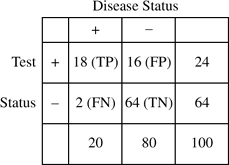Use medical tests judiciously
Madan Dharmar MD
What to Do – Gather Appropriate Data, Interpret the Data, Make a Decision
Using the appropriate test or study for a particular disease helps to optimize the risk-benefit profile of the diagnostic testing and improve the diagnostic capabilities of the test.
Medical tests can be classified into two types: screening tests and diagnostic tests. Screening tests are usually applied in the community to identify a disease early and thus able to appropriately intervene as a measure of secondary prevention; and they are also used as a basis for primary prevention. Diagnostic tests are applied to an individual in the clinical setting to identify and provide effective health care to that individual. The results of the tests could fall into one of the four groups:
True positive (TP): when the patient’s test is positive and is diseased
False positive (FP): when the patient’s test is positive but not diseased
True negative (TN): when the patient’s test is negative and is not diseased
False negative (FN): when the patient’s test is negative but is diseased.
An ideal test is one that, when applied to an individual or a population, can separate patients into two groups (TP and TN). In reality, the majority of tests are far from ideal and are influenced by many factors, which affects the way they separate the population into groups. Hence, it is important to know how the test performs before interpreting the test’s results.
The first step in understanding a test is to assess the ability of the test to correctly diagnose the diseased and nondiseased. Sensitivity and specificity are test characteristics that help to access the ability of the test to make that distinction in an individual.
The sensitivity of a test is the ability of the test to correctly identify the diseased. It could also be defined as the proportion of TP among the diseased [TP/(TP+FN)].
The specificity of a test is the ability of the test to correctly identify the individual as not diseased. It could also be define as the proportion of TN among the not diseased [TN/(TN+FP)].
To illustrate with an example, let us consider a population of 100 people, of whom 20 are diseased and 80 are not diseased. Let us say that when each of the individuals was tested using Test A, we found that 18 were correctly identified as diseased (TP) and that 64 were correctly identified as not diseased (TN).
 |
Sensitivity of the test = TP/(TP+FN) = 18/20 = 0.90 (90%)
Specificity of the test = TN/(TN+FP) = 64/80 = 0.80 (80%)
It is important to understand that tests may be chosen based on the situation it is being applied to the individual. It is essential to understand the impact of false positive and false negative before choosing a test. A positive result in a screening test may need to be followed with more tests to confirm the disease, which could be burdensome to the health system; and it could cause anxiety and worry in the person who had been told that the test was positive when he or she was, in fact, not diseased. A person who has been diagnosed as positive based on false-positive results from a screening test may never be able to remove that label, even when it was later found to be negative on subsequent evaluation. Similarly, consider the impact of a false-negative test result in a diseased individual, especially with a serious disease, which, when diagnosed in a timely manner, could affect management of that disease (e.g., early stages of cancer).
Stay updated, free articles. Join our Telegram channel

Full access? Get Clinical Tree


